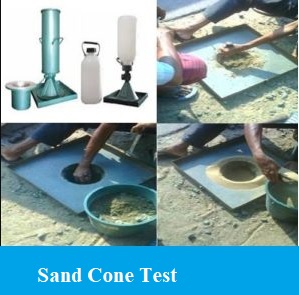Sand Cone Test is used to calculate the dry density and water content of compacted soils placed during the construction of earth embankments, road fill, and structural backfill.
Sand Cone Test also know as Sand Replacement Test.

Sand cone test can be used to determine the in-place density of natural soil deposits, aggregates, soil mixtures, or other similar materials.
Table of Contents
Apparatus
The required apparatus is as follows.
- Sand pouring cylinder
- Pouring cone
- Calibrating metal container
- Metal tray ( 300mm square and 40mm )
- Moisture content cans
- Oven
- Desiccator

Test Procedure of Sand Cone Test
- To start with, take the weight of the unfilled sand cone afterward fill it with dry sand, and afterward weigh once more.
- Gather the excavated soil from the opening and measure the weight.
- After weighting, gather the specimen of soil to calculate the water content in it.
- Now place the sand cone on the test hole with the assistance of the base plate and permit the sand to run by opening the control valve.
- At the point, the sand stops running, close the valve, and weigh the cone with the current sand. At last, figure the dry thickness of the soil by given the beneath formula. On the off chance that the test falls flat, minimized, and perform the test once more.
Calculation:
The volume of the hole = Mass of sand in hole/Density of utilized sand.
Wet density = Mass of wet excavated soil/Volume of hole
Dry density = Wet density × 100%/ Moisture content of soil + 100
Degree of compaction = Dry density × 100%/Maximum dry density.
Degree of Compaction in Field Density Test
The degree of compaction for different types of fill should follow the below table.
| Base Layer | 98% |
| Sub-base Layer | 98% |
| Type 1 Layer | 95% |
| ABC layer | 100% |
| Road shoulder | 98% |
